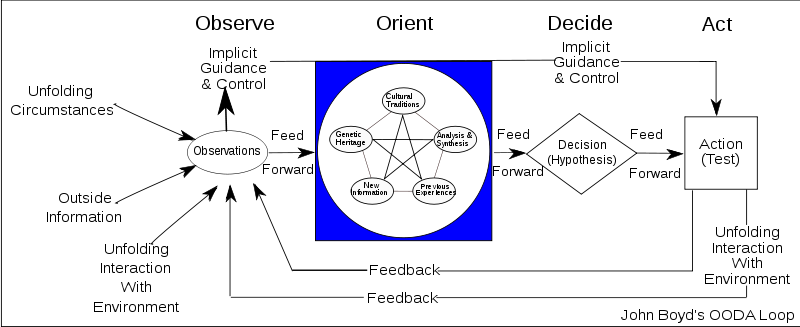There has been a resurgence or maybe recognition of the use of the OODA Loop as a basis for much of the current ideas surrounding Iterations, Rapid Development Cycles and Decision Making. What makes the OODA Loop such a popular subject? When we first think of the OODA Loop, we think of fast competitive cycles needed by a fighter pilot to gain a differential advantage. Is that the reason?
A little more insight was provided several years ago in an article, The Strategy of the Fighter Pilot written by: Keith H. Hammonds for Fast Company. An excerpt from the article:
Business is a dogfight. Your job as a leader: Outmaneuver the competition, respond decisively to fast-changing conditions, and defeat your rivals. That’s why the OODA loop, the brainchild of “40 Second” Boyd, an unconventional fighter pilot, is one of today’s most important ideas in battle or in business.
Bower and Hout’s classic example — and one that Boyd also studied — was Toyota, which designed its organization to speed information, decisions, and materials through four interrelated cycles: product development, ordering, plant scheduling, and production. Self-organized, multifunctional teams at Toyota, they observed, developed products and manufacturing processes in response to demand, turning out new models in just three years compared with Detroit’s cycle of four or five.
Systems like Toyota’s worked so well, Boyd argued, because of Schwerpunkt, a German term meaning organizational focus. Schwerpunkt, Boyd wrote, “represents a unifying medium that provides a directed way to tie initiative of many subordinate actions with superior intent as a basis to diminish friction and compress time.” Employees decide and act locally, but they are guided by a keen understanding of the bigger picture. In effective organizations, Schwerpunkt connects vibrant OODA loops that are operating concurrently at several levels. Workers close to the action stick to tactical loops, and their supervisors travel in operational loops while leaders navigate much broader strategic and political loops. The loops inform each other: If everything is clicking, feedback from the tactical loops will guide decisions at higher loops and vice versa.
Many organizations start practicing the tools of Lean and fail to understand that it is the people side that makes Lean effective. I have seen where organizations will develop the skill set of Value Stream Mapping, A3 Problem Solving or even Hoshin Planning. But spend little time developing a Lean attitude around the most basic concepts of Visual Management, Overlapping Responsibilities or Individual Kaizen. As a result, they simply do not act like a Lean Company. They are a collection of their tools not a collection driven by culture. The mistakes that you were trying to correct by instilling Lean continue to happen. Teamwork is non-existent and individual silos remain. Leader Standard Work is the foundation required for flexibility. It provides the foundation, structure, to adapt.
Jim Benson, author of a Personal Kanban: Mapping Work | Navigating Life made the following quote: A system that is not malleable, is brittle. A process which cannot adapt to context is waste. One size does not fit all Terry Barnhart, in a Business901 podcast, Applying the OODA Loop to Lean expanded that thought….Have you heard about anti-fragility? Taleb’s account is brilliant; it is like the package that says, “Anti-fragile: Please handle poorly, it will improve the contents.” This means a flexible system, but one that builds additional flexibility as brittleness is found. It means an adaptable system that gets more adaptable in adapting to emergent issues. It means a size that adjusts by itself.
The OODA Loop when observed is actually the CAP-Do cycle when applied to Lean Language. The strength of OODA Loop is in the first two steps, Observe and Orientate. Just as Check and Act are in CAP-Do. In Boyd’s terminology, the D in the OODA Loop stands for Decision or formulating the Plan to carry out the Hypothesis. He uses A, act to perform the hypothesis or the Do cycle. I believe CAP-Do, the OODA Loop, is the best way to apply Lean in an external environment.
For more information on Leader Stand Work, Review the Business901 Training page.
For more information on applying CAP-Do and the OODA Loop attend the Lean Sales Method Webinar

